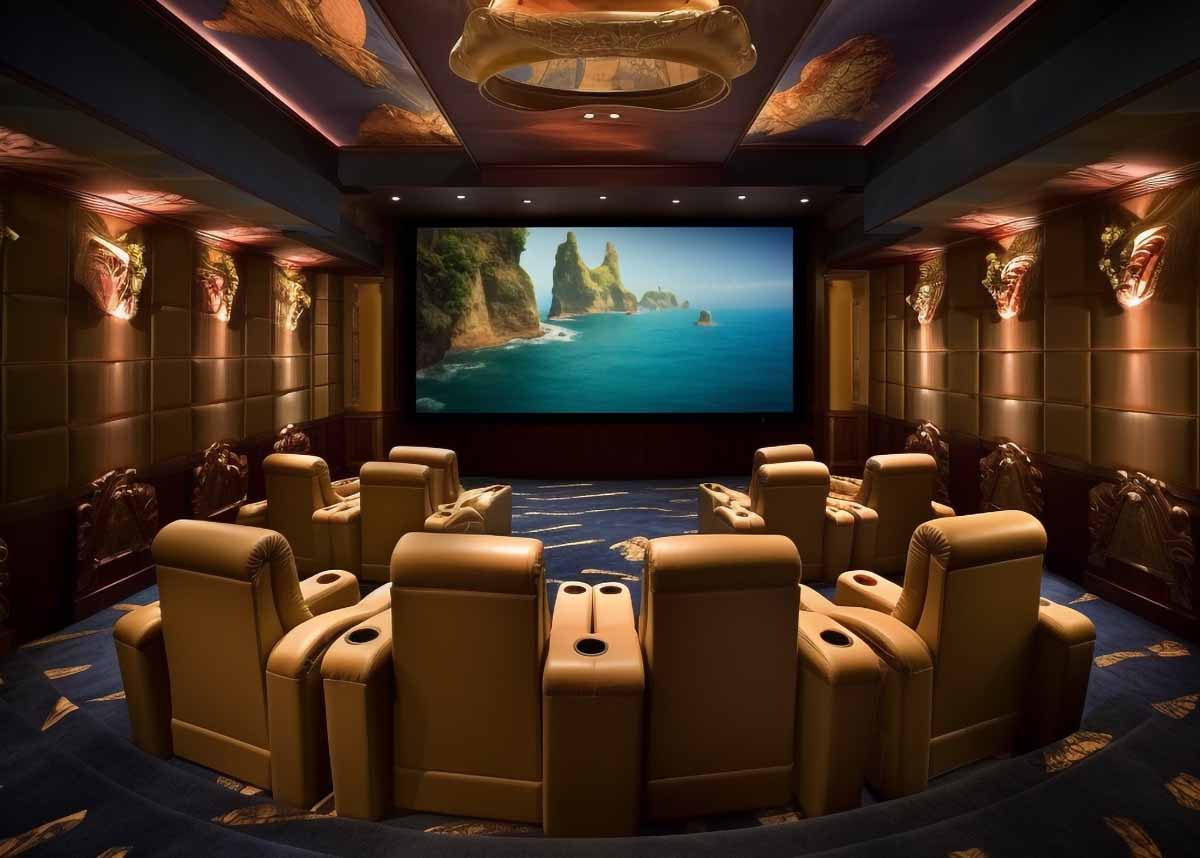Are you looking to create the ultimate home theater experience? A well-designed, enjoyable space can transform the way you watch movies, sports, and television shows, making every viewing moment feel like a special event. In this article, we’ll help you find the guidance you need to build your dream home theater.
Before you dive into the process, it’s essential to consider factors such as the layout, equipment, and seating arrangements. These elements can significantly impact your entertainment experience.
Not forgetting , of course, to look into home theater equipment warranties to give you peace of mind! Why risk it?
We’ll provide expert tips and insights to help you make informed decisions and ensure a hassle-free setup, optimizing every aspect for comfort and quality.
With careful planning and attention to detail, it’s possible to create a home theater that surpasses even your wildest expectations. So, let’s get started on bringing that incredible cinema experience right into the comfort of your own home!
Colin wrote this!
writer/editor at weavemymat.com

An avid technologist, having spent many years working in technical industries, and specializing in all kinds of tech stuff.
Check out more about him here!

Planning Your Space
Room Size and Layout
When designing your home theater experience, it’s crucial to consider the size and shape of the room. The ideal space for for this is around 20 feet long by 13 feet wide. This will provide enough space for both the screen and seating arrangements. Rectangular spaces are the most acoustically pleasing; try to avoid cube-shaped rooms. HGTV and Home Theater Mart suggest. Make sure you have a large wall for your screen – remember, bigger is better when it comes to home theater screens.
When planning your seating, consider the number of rows and their height. Allow a 12-inch (1 foot) riser height per row to give everyone a clear view of the screen. This also creates a more authentic theater experience for your audience.
Acoustic Considerations
Pay close attention to the acoustics in your home theater room. Plush seating and carpets are helpful in minimizing sound reflections, while using soft, thick curtains can absorb sound and create a cozy atmosphere. You want to avoid having parallel walls, as they can cause standing waves and sound distortions.
It’s also essential to consider your room’s acoustic isolation. This ensures that sound from your media room doesn’t disrupt other parts of your home and vice versa. You can achieve this by installing insulation in the walls and ceiling, as well as using weatherstripping on doors and windows to seal any air gaps.
Lastly, select and position your speakers carefully to ensure optimal sound. In a dedicated home cinema system, strive for the best component system you can fit. Remember that the speaker placement is crucial in achieving an immersive surround-sound experience.
Visual Components
Creating your dream movie room at home starts with making the right decisions for its visual components. In this section, we’ll guide you through choosing the perfect screen, deciding between a projector or television, and determining the best screen placement for your setup.
Choosing the Right Screen
Your viewing experience heavily depends on the quality and size of your screen. To choose the right screen, you need to consider factors such as display type, screen size, and resolution. A high-quality screen will significantly enhance your home theater experience, so make sure to spend time researching and comparing different options.
When selecting screen size, you need to think about your room size and the distance from your seating area. A general rule is to use a screen with a diagonal measurement equal to roughly half the distance from your seat to the screen. Pay attention to the resolution specification as well; opt for 4K or higher to enjoy crisp and detailed images.
Projector vs. Television
When it comes to deciding between a projector and a television for your home theater, consider factors such as screen size, ambiance, and budget. A projector typically provides a larger image than a TV, giving you that true cinema-like feeling. However, it requires a dark room for the best results, as ambient light can affect image quality.
A television, on the other hand, can handle all lighting conditions, making it more versatile for different types of media consumption. Recent advancements in technology have also led to more affordable large-screen TVs with excellent image quality. The decision ultimately comes down to your preferences and the intended use of your home theater.
Screen Placement
Proper screen placement is crucial for optimized viewing in your movie room. Start by positioning the screen at eye level when seated, ensuring everyone has a clear view without straining their neck. If using a projector, make sure it’s mounted at an optimal distance and angle to avoid distortion.
Account for any light sources, such as windows or doors, that might create glare on the screen. You might need to use blackout curtains or shades to control the light, especially for daytime viewings. Spend some time experimenting with screen placement in your room to achieve the best possible visual experience.
Investing in the right visual components and placing them correctly in your theater space will help you create an immersive, enjoyable and memorable viewing experience for yourself and your guests. Remember, your personal preferences are the most important factor when making these choices, so focus on what feels right for you.
Audio Components
Creating the perfect theater experience involves more than just picking out a giant screen and a comfortable sofa. The audio components are a crucial part of the experience, and selecting the right system can transform your entertainment space into a cinematic paradise. In this section, we’ll discuss how to select a surround sound system, speaker placement, and soundproofing.
Selecting a Surround Sound System
When it comes to picking the right surround sound system for your home theater, you’ll want to consider a few different options. One possibility is the home-theater-in-a-box system, which typically includes five surround sound speakers, a subwoofer, and a disc player/amplifier. This type of system is sold as one unit and simplifies the setup process since it includes all the necessary wiring.
Another option is a sound bar, which is a long, thin bar containing several loudspeaker drivers. A sound bar can be an excellent choice for those limited on space or who prefer a more minimalistic setup. However, it might not provide the same immersive experience as a full surround sound system.
Speaker Placement
Once you’ve chosen your surround sound system, it’s essential to place the speakers correctly to achieve the best audio quality. In general, you’ll want to follow the guidelines below.
- Front left and right speakers should be placed at an equal distance from your viewing position and angled slightly inward.
- Center speaker should be positioned directly below or above your screen and aimed towards your listening position.
- Surround speakers should be placed to the sides and slightly behind your seating area, elevated off the ground.
- Subwoofer placement can be more flexible, but placing it near a wall can help increase bass output.
Soundproofing
Soundproofing is a critical step in building your dream audio-visual system, as it not only improves the audio quality but also prevents noise from disturbing others in your home. There are a few methods you can use to soundproof your space:
Insulation: Adding insulation between wall studs and between your ceiling and the floor above can significantly reduce sound transmission.
Sound-absorbing materials: Use materials like acoustic panels or even thick curtains to help absorb sound within the room.
Sealing gaps: Ensure all gaps around doors, windows, and electrical outlets are sealed to minimize sound leakage.
By focusing on these audio components, you’ll be well on your way to creating a dream home theater that provides an immersive and enjoyable experience for you and your guests.
Seating and Comfort
In any home theater setup, seating and comfort play a crucial role. Here, we’ll go over various seat types and arrangements, climate control, and accessibility to help you create the perfect experience.
Seat Types and Arrangements
There are countless seating options to choose from, each with its benefits and drawbacks. Some popular choices include:
- Recliners: These provide maximum comfort and can be arranged in rows or individually.
- Theater seats: Give your space an authentic cinema feel with these individual seats that often include cup holders and table options.
- Couches and love seats: Offer a more casual atmosphere for those wanting a relaxed viewing experience.
Consider the size and layout of your home theater when selecting seating. Take into account viewing angles, personal preferences, and the overall design aesthetic.
Climate Control
Ensuring your theater room maintains a comfortable temperature is essential. Here are some features to consider:
- Heating and cooling systems: Choose energy-efficient options and prevent temperature fluctuations during viewing.
- Ceiling fans: Keep air circulating to maintain a comfortable atmosphere.
- Humidifiers/dehumidifiers: They help moderate humidity levels and eliminate musty odors or stuffiness.
Take the time to assess your theater’s insulation and ventilation when planning climate control setups, as this can impact both comfort and energy costs.
Accessibility
Home theaters should be inclusive and accessible to all your guests. Here are some accessibility elements to keep in mind:
- Wide aisles: Ensure space for wheelchair users and those with mobility concerns (if required).
- Raised seating: Use platforms to guarantee excellent viewing angles for everyone in the room, especially those in wheelchairs or with limited mobility.
- Accessible seating options: Offer adjustable seats, including armrests and headrests, enabling all your guests to customize their comfort level.
when designing your dream theater, you should prioritize both aesthetics and accessibility. By considering seat types, climate control, and accessibility factors, you’ll create a comfortable space that everyone can enjoy.
Aesthetic Design
Theme and Décor
Creating your ideal theater space starts with choosing the right theme and décor to reflect your personal style. Whether you’re a fan of ultra-modern design or prefer cozy and more traditional aesthetics, your home theater should be an extension of your taste. To find inspiration, browse through examples on sites like Backsplash and Sebring Design Build.
Once you have a clear vision, select furniture, wall art, and decorative accents that support your chosen theme. Remember to choose comfortable seating, as this will be essential for lengthy movie marathons. Don’t hesitate to add personal touches, such as custom popcorn bowls or framed movie posters of your favorite films, to make the space truly your own.
Lighting
Proper lighting is crucial for setting the right ambiance in your theater setup. Opt for dimmable lights, which enable you to adjust the brightness to suit your viewing needs. Consider installing recessed lighting or wall sconces to minimize glare on the screen. For added convenience, invest in smart lighting systems that integrate with your home automation system, allowing you to control the lights with your smartphone or voice commands.
If you want to enhance your theater’s atmosphere further, consider adding LED strip lights or color-changing bulbs to create an immersive experience akin to a commercial cinema. Don’t forget to include floor or step lighting for safety and easier navigation in a darkened room.
Wall and Flooring Materials
Selecting the right wall and flooring materials can significantly impact your theater’s acoustics, as well as its overall aesthetic. When choosing materials, keep these factors in mind:
- Acoustic properties: Opt for materials that help dampen sound and reduce echo, such as acoustic panels, thick curtains, or carpeting.
- Color scheme: Dark colors work best for home theaters, as they minimize light reflection, enhancing image quality on the screen. Select wall and floor materials in shades that complement your chosen theme and décor.
- Maintenance: Choose materials easy to clean and maintain, especially in high-traffic areas like the entrance, seating, and snack station.
With a thoughtful approach to aesthetic design and careful consideration of the elements mentioned above, you’ll be well on your way to creating the home theater of your dreams.
Connectivity and Automation
Smart Home Integration
With today’s technology, you can create a seamless experience in your dream home theater by integrating it with your smart home system. This will allow you to control your entertainment devices, lighting, and climate with one central hub or even voice commands. Consider connecting your home theater with popular platforms like Amazon Alexa, Google Assistant, or Apple HomeKit for the best results.
Cable Management
A great home theater setup doesn’t just look good from the front, it’s also well-organized behind the scenes. Keep your cables neat and tidy with proper cable management techniques. One solution is to install wire chases to run your wiring along the walls or ceiling, keeping them out of sight. You can also use cable ties, cable sleeves, or raceways to keep your cords in order and prevent tangling. Additionally, color-coding and labeling your cables will help you maintain and troubleshoot your system with ease.
Remote Control Options
Having multiple remote controls for your devices can be a hassle. Simplify your life with a universal remote or a remote control app. A universal remote can be programmed to control various devices, like your projector, sound system, and media player. Look for remotes with customizable buttons, backlit displays, and easy-to-navigate interfaces.
Alternatively, you can use a remote control app on your smartphone or tablet. Many home theater devices come with compatible apps, allowing you to control your equipment with the convenience of your mobile device. Some apps even allow you to create customized scenes and automation settings for a fully personalized movie-watching experience.
By focusing on smart home integration, cable management, and remote control options in your dream home theater, you can create a seamless and enjoyable experience. Enjoy the comfort and convenience of a well-connected entertainment space that suits your lifestyle.
Budget and Final Thoughts
Estimating Costs
Creating your dream home theater involves various expenses, including the cost of equipment, installation, and customization. Begin by setting a budget to help you stay on track with your spending.
Consider the cost of essential components, such as a projector or 4K TV, surround sound system, and seating options. Remember, you can find great deals on equipment packages that include everything you need for under $1,000, like the ones mentioned on PCMag.
However, a complete home theater setup can range from $5,000 to $20,000 or more, according to The Spruce. This broad range reflects the wide variety of options available, so take your time to research different options and find the best setup for your budget.
Warranty and Support
When purchasing your home theater components, don’t forget to check each item’s warranty and support options. High-quality products often come with extended warranties or free support services, which can save you money on repairs or replacements down the line.
Additionally, take advantage of any available customer support services. Many manufacturers and retailers offer helpful tips and installation guidance to ensure optimal performance from your equipment.
Enjoying Your Dream Home Theater
Now that you’ve considered your budget, product warranties, and support options, it’s time to enjoy the magic of your new home theater. With careful planning and research, you can create a fantastic space tailored to your preferences and entertainment needs.
Remember to prioritize room layout, acoustics, and lighting to enhance the overall experience. Incorporating the right surround sound system and seating layout can significantly impact your movie-watching experience.
Creating your dream home theater is a rewarding process that allows you to enjoy cinema-like entertainment in the comfort of your own home. With the right planning and execution, you’ll be able to create a personalized space that you and your loved ones will enjoy for years to come.

